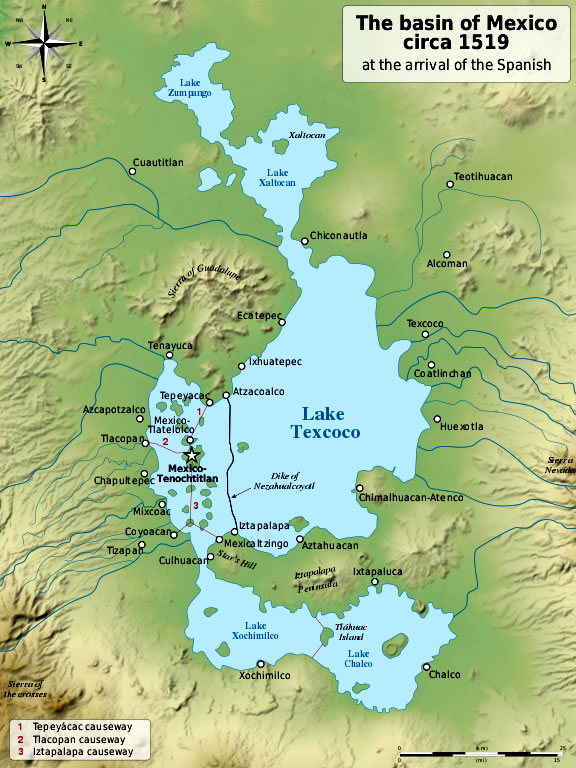Like a giant bowl gouged out of the Earth, ringed by mountains and active volcanoes, the Basin of Mexico, the site of contemporary Mexico City, is one of the world’s most ancient and important cradles of human civilization. Conventionally called the Valley of Mexico, this singular geographic feature has no outlet to the sea, and thus technically is a basin, not a valley.
Tectonically unstable, ranging in elevation from 2,000 to 2,400 meters above sea level, and extending roughly 110 kilometers north to south and 80 kilometers east to west, the Basin of Mexico covers an area of approximately 7,000 square kilometers. Prior to the conquest of Mexico, the basin’s diverse ecological zones saw the rise and fall of diverse city-states and kingdoms.
Because it formed a closed hydrological system, and because it has ample volcanic and alluvial soils, the basin evolved a complex network of lakes, streams, and springs that also made it one of the richest and most productive ecological zones in all of Mesoamerica.
  |
The basin’s first human inhabitants, arriving some 15,000 years ago, found an environment teeming with life—not only birds, fish, plants, and insects but a staggering diversity of mammals like rabbit, fox, pigs, deer, wolves, as well as camelids, horses, mammoths, mastadons, giant sloths, bears, and other large prey.
Initially a hunter’s paradise, the basin had by 9,000 years ago seen its largest fauna become extinct, probably due to a combination of climate change and anthropogenic pressures. The beginnings of maize cultivation, which later provided the economic underpinnings for the development of complex societies and civilizations across Mesoamerica and beyond, began in or near the basin around 5,000 b.c.e.
It is hypothesized that the absence of large draft animals suitable for domestication delayed for several thousand years the emergence of fully sedentary societies. As late as 1,000 b.c.e., the entire basin was home to an estimated 10,000 inhabitants—a tiny fraction of its carrying capacity, and of what it would be two millennia later.
 |
| Basin of Mexico in the 15th century |
Beginning around 1100 b.c.e., in the basin’s wetter southern zones, conscious manipulation of the basin’s abundant water resources marked the beginnings of an agricultural revolution, and along with it of complex societies that relatively quickly developed into large-scale state systems.
Around 500 b.c.e., to the northeast the construction of irrigation ditches and other water-control mechanisms permitted the emergence of the basin’s first true city and state, Teotihuacán. Around the same time, a host of other polities emerged around the five interconnected shallow lakes that dominated the basin’s center—from south to north Lakes Chalco, Xochililco, Texcoco, Xaltocán, and Zupango.
From around 100 b.c.e., and continuing for the next 16 centuries, there emerged an exceedingly intricate array of polities, kingdoms, and city-states across the basin, most with their capital cities located near the lakes at the basin’s center, the exact sequence and relationships of which scholars are still endeavoring to understand. The Aztecs built their capital city Tenochtitlán atop what began as a small island on the western edge of Lake Texcoco, the basin’s central and largest lake.
   |
By the time of the Spanish arrival in 1519, the Basin of Mexico was home to an estimated 2 million to 3 million people, making it one of the most densely packed areas in the world, with an average population density of from 300 to 500 persons per square kilometer.
After the conquest, the Spanish devoted enormous resources to draining the giant lakes. In the early 21st century, the Basin of Mexico was home to the world’s second-largest megalopolis and an estimated 25 million to 30 million people.
